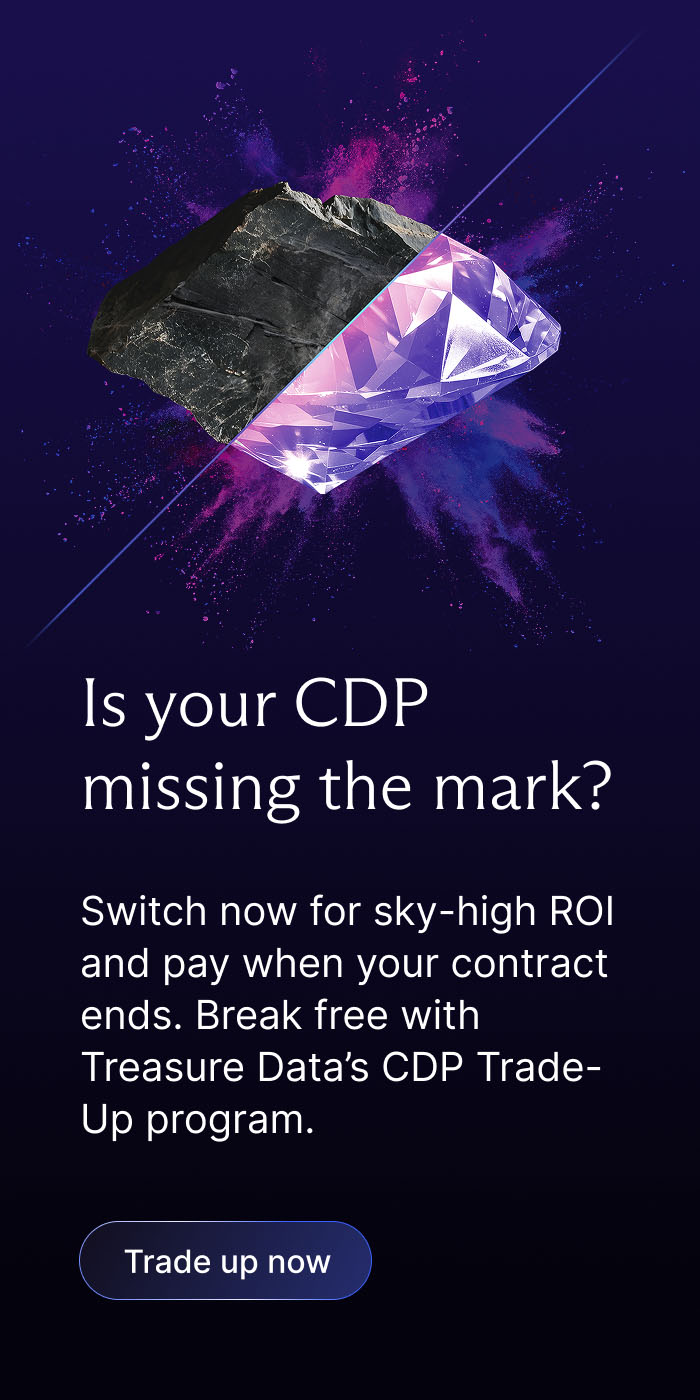To choose the right customer data platform (CDP), you should:
- Establish a team of CDP stakeholders
- Understand your company’s level of digital maturity
- Define your CDP use case roadmap
- Gather CDP RFP requirements
- Align on scoring criteria for CDP evaluation
- Have a process for collecting stakeholder feedback
- Start with a Proof-of-Concept (POC)
The right customer data platform (CDP) can improve the efficiency of your data-driven marketing campaigns, sales outreach, customer service interactions, and data operations. CDPs also help IT and data teams establish data governance policies, integrate consent management, and manage personal data in compliance with regulations.
According to Gartner, in the 2025 Magic Quadrant for Customer Data Platforms (courtesy of Treasure Data), a CDP is defined as software applications that support marketing and customer experience use cases by unifying a company’s customer data from marketing and other channels. CDPs optimize the timing and targeting of messages, offers, and customer engagement activities, and enable the analysis of individual-level customer behavior over time.”
Since your CDP will serve as the customer data foundation for your organization, picking the right platform is critical to achieving both short-term and long-term ROI. If you rush into the decision and choose the wrong CDP, or one that doesn’t scale, replacing a technology infrastructure decision is no small undertaking. That’s why it’s essential to take the time to ensure that the vendors you are evaluating have the right experience for your industry, and that their platform will drive real business value for your organization now and for years to come.
Just Released: The Forrester Wave™: Customer Data Platforms for B2B, Q3 2025. Access your complimentary copy, courtesy of Treasure Data, to discover the 11 B2B CDP providers that matter most and how they stack up, along with scorecards on providers’ current offering and strategies.
What to Consider When Choosing the Right CDP
A well thought-out and carefully planned CDP selection process is going to make all the difference for success and ROI in the long term.
A CDP is a MarTech infrastructure, so you want to future-proof your investment by ensuring you ask the right questions about vendor capabilities during the RFP process. Doing your due diligence upfront will ensure you maximize the value of your organization’s CDP investment over time.
Here are six things to consider when choosing the right CDP for your organization.
1. Establish a Team of CDP Stakeholders
Who are your stakeholders? A CDP ingests data from across the organization, so engage the teams that already collect customer data. This would typically include marketing, analytics, sales, customer service, marketing operations, the IT team, and the web team. You may also want to include stakeholders from security, strategy, product, and operations.
Getting the right people at the table is critical, so you will need a cross-functional team with a well-thought-out plan and strategy. Other stakeholders could include:
- Legal: Some industries, like financial services, life science and healthcare are heavily regulated. It may be smart to include a legal representative in the planning process to inform the team of potential legal issues that may arise from the project.
- CDP Implementation Partners/Internal Champions: The right CDP vendor will have an experienced team of CDP practitioners who can assist in CDP integration and interconnectivity. However, it’s important to identify and include people who will work with your vendor to provide internal industry and customer expertise, and shepherd CDP adoption once implementation is over.
- External Consultants: Depending on your internal staffing, level of data maturity, and what resources you vendor can support, you may need to employ other external digital transformation partners to fill in gaps in skills and talent. You may be looking for a MarTech consultant or services agency to help support your internal team.
2. Understand Your Company’s Level of Digital Maturity
Digital maturity is defined as an organization’s ability to respond to shifting technology trends in order to create value that provides a competitive advantage. When a digital transformation roadmap is defined, it looks at where the organization is in terms of its digital maturity to understand how to move forward.
Digital maturity is based on a number of factors, such as company size and age, existing legacy technology and processes, and internal resources that are able to effectively adopt and maximize the value of new technologies.
Defining the right CDP use cases to implement along the journey is part of this process to ensure quick wins, and deliver long-term value.
3. Define Your CDP Use Case Roadmap
What are your primary CDP use cases? What are you really looking for a CDP to accomplish? Talk to your stakeholders and make sure you address their needs as well as yours. Delivering value across the organization will make getting compliance much easier. It’s always a good idea to model against simple use cases, maybe two to three to start with, so you don’t get overwhelmed by trying to boil the ocean. Are you primarily looking to personalize the digital customer experience to drive higher loyalty? Or is data privacy management your main concern?
Overall, the team should look at market and customer-centric use cases, as well as opportunities to target new markets, pilot new products, and improve customer experiences. Focusing on growth opportunities enables business model evolution, helps the team shift away from legacy business practices, and leads to future investments in quality improvements, automations, and other operational benefits.
4. Gather Request for Proposal (RFP) Requirement
Defining your top CDP use cases and where your company stands when it comes to data maturity will help you build a CDP roadmap that will inform the questions you should ask during the vendor selection process.
The CIO and CDO should review the business opportunities, integration needs, compliance factors, and technology capabilities of CDP vendors. The CIO leads the due diligence, evaluating the scalability, security, and flexibility of different CDP solutions. They can also identify opportunities for self-service capabilities, and align solutions around data governance policies and compliance.
While it’s important to focus on the immediate requirements you’ll need to achieve initial use cases, it’s also important to make sure you’re establishing the right criteria to ensure you’re selecting a vendor that has the flexibility and scale to grow with your needs over time.
Focusing on growth opportunities enables business model evolution, helps the team shift away from legacy business practices, and leads to future investments in quality improvements, automations, and other operational benefits. This will help you achieve your longer term goals around ROI, operational efficiency, innovation, and growth.
5. Align on Scoring Criteria for Vendor Evaluation
Starting with use cases and requirements is a necessary step, but they don’t tell you about the more intangible qualities of what support a vendor can provide. Look at the clients, executions, and the history of the CDP vendor you are reviewing. Some companies also enlist the help of consultants or industry analysts who can assess your goals and make recommendations on which vendors to include based on your criteria.
The CDP demo is a vendor’s opportunity to demonstrate their capability to handle your needs, so it’s important to make sure you have the right framework in place to make the most out of demo meetings. Ask vendors to demonstrate how they would solve for your key use cases, and give situations of challenges that your organization may face. This helps your team evaluate how the vendor would approach solving a problem, and if their strategy makes sense for your organization.
Pro Tip: Make sure you collect RFP responses before setting up demos. In some cases, initial RFP responses may disqualify certain vendors on your list before you even get to setting up a demo. This enables you to spot and remove unqualified vendors early, so you can make demos more efficient.
6. Have a Process for Collecting Stakeholder Feedback
Throughout the entire process, it’s important to keep communication and collaboration front and center. Hold follow-up meetings to collect feedback from key stakeholders, and keep notes organized so you can follow up with vendors accordingly. You may even want to develop a scorecard your team can use to rate against your scoring criteria to make evaluations easier.
7. Start with a Proof of Concept (POC)
Data analytics software is a significant investment. It is crucial to try before you buy with a proof-of-concept (POC) test project. A proof of concept is typically a smaller-scale pilot project whose goal is to demonstrate, in principle, that the idea has practical potential without requiring full development. Running a POC on any large software project is critical to ensuring it is the right fit for your business and its present and future needs. Starting with a POC will ensure that your investment remains future-proof for years to come.
Choose the Right Customer Data Platform for You
Spending time to do a thorough due diligence on your potential customer data platform and its corresponding vendor will set your company up for success.
Our comprehensive CDP RFP guide and complimentary CDP RFP template explores the key steps needed to create a successful CDP evaluation and selection process – from the capabilities to consider, to the questions you should ask prospective vendors to make sure you’re making the right decision.
Access your copy of our guide and complementary CDP RFP template here.




